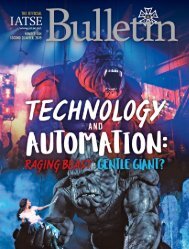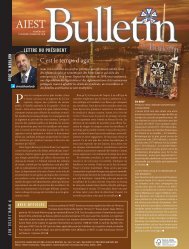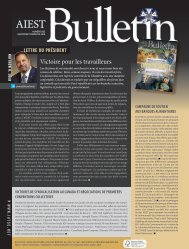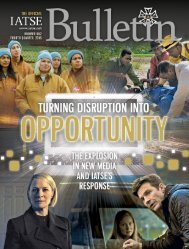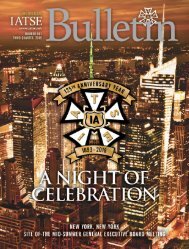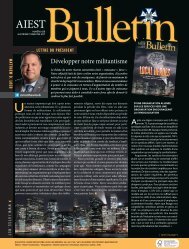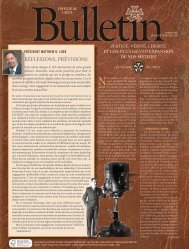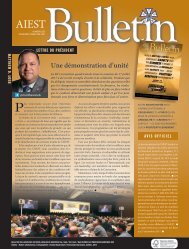IATSE-2nd2018_web
You also want an ePaper? Increase the reach of your titles
YUMPU automatically turns print PDFs into web optimized ePapers that Google loves.
flammable and could be ignited by even the smallest spark. In<br />
addition, it emitted noxious gases.<br />
Alliance projectionists struggled to win a work rule for a twoperson<br />
booth. Having an extra person in the booth would make<br />
it safer for the workers and assure quality in the projection of<br />
films, especially talking pictures. The theater owners’ insistence<br />
on keeping only one person in the booth led to an extended<br />
period of disputes, aggravated by declining box office revenues.<br />
At the same time, <strong>IATSE</strong> was intensifying other efforts<br />
on behalf of projectionists, as well as studio craft workers in<br />
Hollywood. There were two systems for movie sound in 1928:<br />
Vitaphone’s disc-based system which required projectionists<br />
to handle a lot of equipment all at once; and Fox’s sound-onfilm,<br />
which also required someone to operate faders.<br />
No one knew which system would ultimately be adopted<br />
by the industry, but <strong>IATSE</strong> was determined to protect the<br />
jurisdiction of its projectionists. Whichever system was<br />
finally accepted, it must be operated by IA members and no<br />
one else.<br />
THE GREAT DEPRESSION<br />
With the stock market crash of 1929 (headlined by Variety as “Wall Street Lays An Egg”), the bottom fell out of the box<br />
office. Unemployment soared and theater attendance plummeted. The movie houses were hurt, but the legitimate theater<br />
suffered even more.<br />
Some projectionist Locals responded by taking in stagehands<br />
and re-training them to join their craft. This was only a temporary<br />
fix. As the depression deepened, union projectionists who had<br />
worked at the same theater for years now found themselves<br />
locked out at contract time, as owners hired low-wage, nonunion<br />
projectionists as replacements.<br />
Projectionists working for Loews and Publix eventually<br />
made wage concessions. Other Locals followed suit. It was a<br />
brutal and difficult time. In cities where union projectionists<br />
were locked out, there was violence and there were attempts to<br />
disrupt performances through stink bombs and other means.<br />
These responses reflected the overall fear and desperation of<br />
the nation, as the Great Depression tightened its grip on the<br />
economy and the psyche of the country.<br />
By May of 1932, more than 300 theaters were operating nonunion,<br />
compared with less than 100 just a few years before. For<br />
the workers in live theater, it was even worse. Estimates are that<br />
as many as 10,000 out of 16,000 IA stagehands were out of work<br />
during this time.<br />
In Canada, the story was similar. Many small-town theaters<br />
closed in the 1930s, forcing <strong>IATSE</strong> members to travel the<br />
countryside in search of employment. Projectionists who had<br />
previously worked only in the booth were now doing everything<br />
from setting up projection equipment, chairs and screens<br />
to distributing advertising, selling tickets and maintaining<br />
equipment and transport vehicles.<br />
Some Canadian IA members even found themselves required<br />
to run dances after the show. They worked long, hard hours for<br />
low rates of pay (as little as $10 a week, roughly equivalent to<br />
$130 Canadian today) and often took eggs, butter, vegetables and<br />
other goods in exchange for admission.<br />
THEATER’S GOLDEN ERA — AND BEYOND<br />
Ironically, the Great Depression overlapped with what is<br />
27




